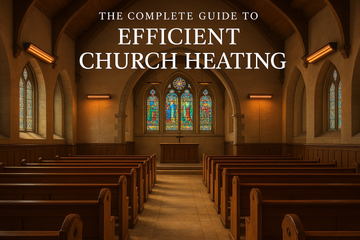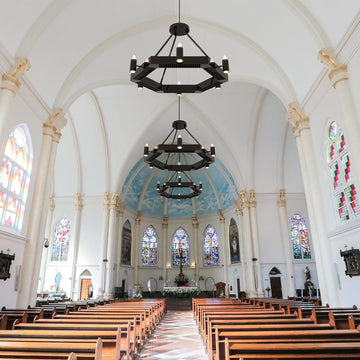Why Infrared Heating is the Best Choice for Heritage Buildings
Heating a heritage building is not a straightforward task. Whether you’re responsible for a listed church, a historic hotel, a centuries-old museum, or a Grade II property, your challenge is twofold: create a comfortable environment for occupants, while protecting the integrity and value of the building itself.
Unfortunately, most traditional heating systems fail at both.
The Problem with Traditional Heating in Historic Settings
Heritage buildings weren’t designed with central heating in mind. Most feature:
-
Thick stone or brick walls that absorb and dissipate heat
-
High ceilings and large volumes of space
-
Little to no insulation
-
Sensitive internal features (woodwork, textiles, artwork, plaster)
-
Strict planning restrictions
Conventional systems like radiators, underfloor heating, or forced air units work by warming the air. In buildings with vast, uninsulated spaces, this results in:
-
Slow response times: Air takes hours to warm, then quickly escapes.
-
Energy waste: Heat rises to the ceiling and gets lost.
-
Condensation issues: Warm air meets cold surfaces, creating damp.
-
Aesthetic disruption: Installing pipes, ductwork or vents is invasive and often restricted in listed buildings.
In short, they’re inefficient, intrusive, and risky.
Why Infrared is Different and Safer
Infrared heating flips the traditional model. Instead of heating air, it warms objects, people, and surfaces directly, just like the sun. This makes it a uniquely efficient church heating systems
Here’s why:
-
No Condensation – Infrared reduces airborne moisture, protecting wooden beams, plaster, and stone from rot, damp, or mould.
-
No Disruption – Units can be wall-mounted, ceiling-suspended, or even disguised as decorative panels, no pipework or structural changes needed.
-
Silent & Invisible – With no moving parts, the system is silent, maintenance-free, and doesn’t alter the building’s character.
-
Zone Heating – Only heat the areas in use: a chapel, a lobby, an aisle of pews. No need to waste energy on the whole volume.
Preservation Comes First
Infrared heating helps maintain the stable temperature and humidity conditions that heritage preservation demands. That means:
-
Less thermal cycling that can damage materials
-
Reduced mould growth and fungal spores
-
Safer conditions for oil paintings, musical instruments, tapestries, or historic books
Whether you’re trying to protect priceless artefacts or ancient woodwork, infrared is a non-invasive, conservation-friendly option.
Real-World Applications
Infrared heating is already trusted in many heritage settings, including:
-
Churches – Where silent, fast-response heating can focus warmth on congregation seating only.
-
Hotels & B&Bs – Where low-profile heaters preserve historic décor in lobbies and rooms.
-
Museums & Galleries – Where wall-mounted infrared ensures visitor comfort without disturbing sensitive artworks.
-
Village Halls & Community Buildings – Where intermittent use makes fast, efficient heating critical.
Read our case study from Baildon Methodist Church to see how they transformed their heating with zero visual disruption.
Discreet by Design
Infrared panels and bar heaters can be:
-
Colour-matched to ceilings or walls
-
Custom-sized to fit architectural spaces
-
Suspended or angled for effective coverage
-
Controlled wirelessly to eliminate control panels or thermostats on listed walls
They blend in. They respect the space. And they work instantly.
Smarter Control, Lower Bills
With the addition of smart thermostats and WiFi zoning, heritage buildings can now:
-
Heat only occupied areas
-
Schedule usage around events or visiting hours
-
Monitor energy usage remotely
-
Reduce annual heating bills significantly
Choosing the Right Infrared System
For larger heritage buildings, we recommend:
- Chandeliers with led lighting - High powered architectural chandelier type infrared heaters which fit with decor
-
Bar Heaters – Powerful, ceiling-suspended units ideal for halls, churches, or public areas.
Summary
When it comes to heating historic buildings, the old solutions no longer fit. Infrared offers a new approach - one that preserves beauty, protects structure, and respects history.
No pipes. No damp. No damage. Just intelligent, efficient warmth that works with the building, not against it.
Want help selecting the right heater?
Contact our team for expert advice and tailored recommendations.
Next steps: choose the right infrared heating
Continue with one of these popular options:
- Shop All Panels, accessories & bundles.
- Wattage Calculator Get the right watts for your room.
- How Infrared Works Benefits, costs & installation.






